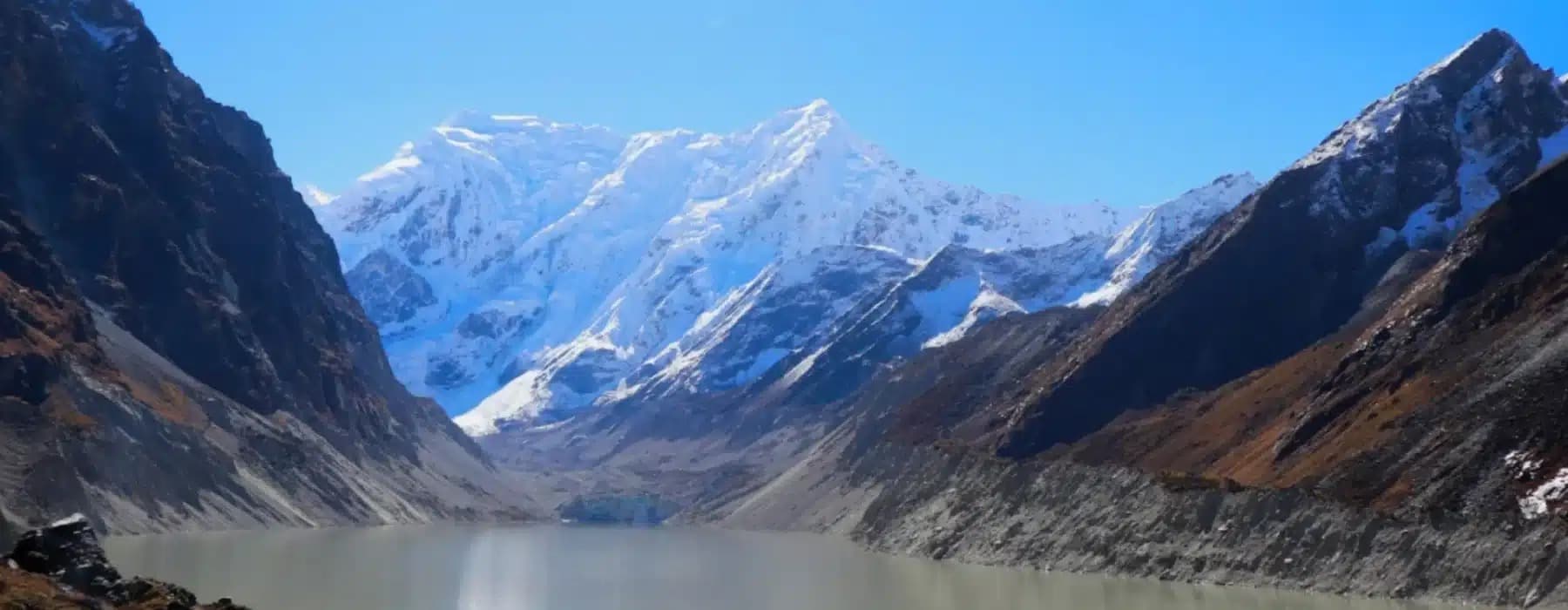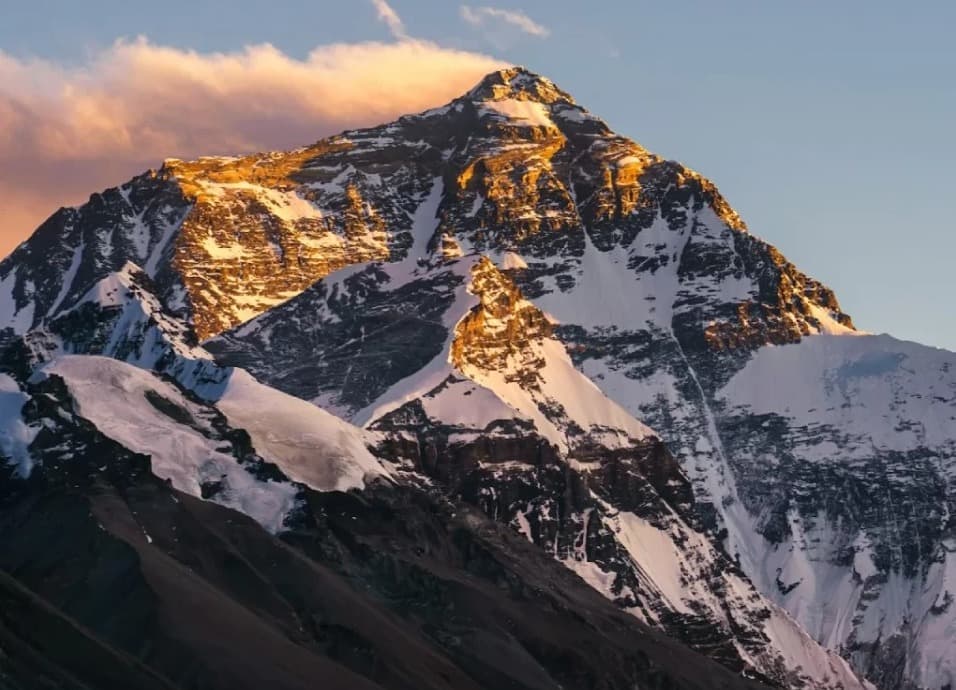Recently, I embarked on an adventure that forever changed my perspective on nature, culture, and the genuine spirit of exploration. My four closest friends and I set out to discover Tsho Rolpa, a stunning glacial lake in the heart of Rolwaling Valley, Nepal.
Also called Cho Rolpa by the locals, it is one of the biggest glacial lakes in Nepal at an altitude of 4580 meters.
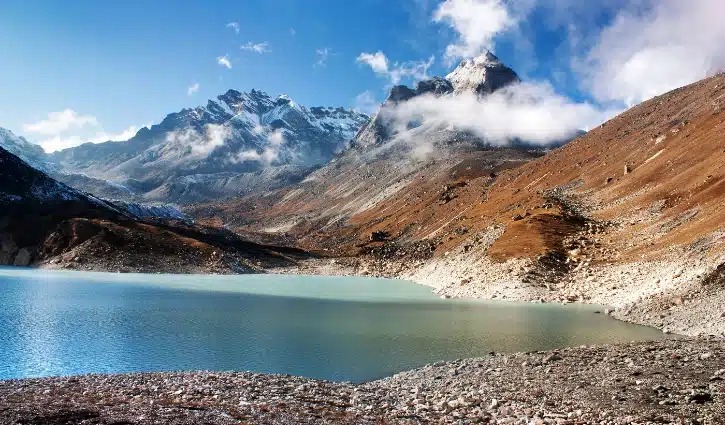
We hiked there in July when the monsoon season was in full swing and the leeches were in their prime. This was an extra challenge. Yet every step on the trail led us to breathtaking waterfalls, stunning landscapes, and hospitable people who welcomed us with open arms as we approached them with a helpless look on our faces.
The trail itself was something spectacular. The valley, framed by hills and mountains, gives the impression of a deep, graceful furrow. It’s no surprise that the name Rolwaling means “Valley carved by a Plow” where rocky ridges and green slopes blend seamlessly.
Despite challenges, this journey to Tsho Rolpa is one of the best travel experiences I have ever had. The combination of natural beauty and unwelcome challenges (especially the leeches) and the company of my friends made this trip an unforgettable one. Thus, I am excited to share this adventure and guide you through the itinerary, food, and transport.
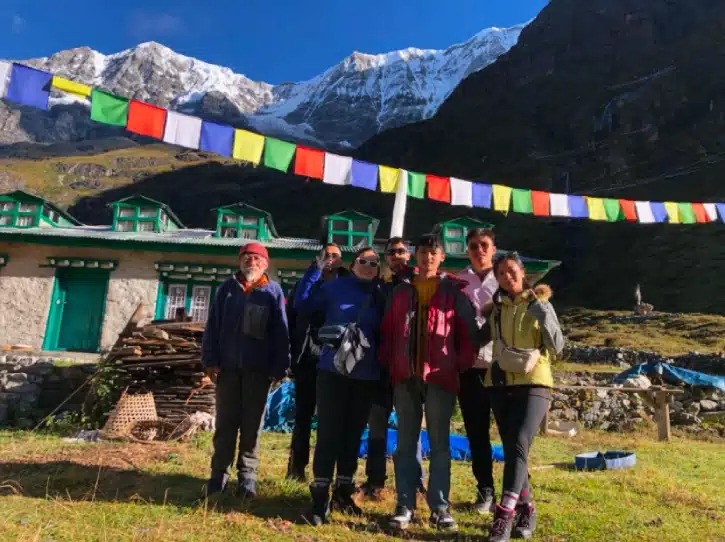
A Quick Itinerary to Tsho Rolpa in the Rolwaling Valley
Day 1: Kathmandu (1350 m) to Simigaun (2019 m)
Early morning on the first day, we sat on a bus to Charikot, Dolakha, from the old bus park in Ratnapark, Kathmandu. We drove around 150 kilometers, which took us over five hours, with a small lunch break. After reaching Charikot, we exchanged for a 3-hour Jeep ride. The Jeep left us below the village of Simigaun, where we settled into our accommodations for the night.
Despite a long road journey and a few leech attacks while walking up the stairs, the first day was already a hit. The cascading waterfalls, beautiful bridges, and terraced farmlands were a treat to the eyes. But Simigaun had more to offer. The village is famous for its traditional alcohol, known as Jhyaukatte (झ्याइकट्टे), and a variety of delicious Nepalese regular diet Dal, Bhat, and Achar that warm our spirits after a long day of travel.
As it was already 6 PM when we arrived, we ate a delicious dinner and snuggled in the bed like a baby.
Day 2: Simigaun (2019 m) To Dongang (2800 m)
The next morning, we set off to Dongang village with a high spirit. Although leeches are notorious during the monsoon season, we were surprised to see so many and constantly fought them off.
Along the way, we passed through three beautiful villages: Uttise (2440 m), Sumurche (2600 m), and Kyalche (2760 m). Each village had its charm and beautiful landscapes surrounded by green hills. By late afternoon, we arrived at the Dongang, weary yet exhilarated from the day’s hike.
The warmth of people in the village was so heartwarming. They greeted us with hot drinks and a much-needed meal after a long day of walking. We sat down and chatted with them to hear their stories of lives in this remote region.
The stunning views of the surrounding mountains and valleys made the trek worthwhile. But it was the people who made it more special. Hearing local stories, we felt a deep connection between the land and its people.
Day 3: Dongang (2800 m) to Beding (3740 m)
Today marks an important day as we saw the first few yaks, the sherpa community, and the beauty of real Rolwaling. As usual, we ate our Himalayan breakfast (Tibetan bread, vegetable curry, boiled egg, and butter tea) and began an early morning trek.
Walking past lush green forests along the Rolwaling River and continuously climbing and descending on the trail, we finally reached Beding Village at around 2 PM. The trail from Dongang to Beding is full of lush green surroundings, waterfalls, and wooden bridges that captivate your attention.
We spent the night at a local lodge in the village of Beding.
Day 4: The Journey to Tsho Rolpa and Dudh Kunda (Milky Lake) and back to Beding
On our third day, we started early at 5 AM. As we walked for 20 minutes, the view of the Gaurishankar range showed up with golden rays of sun. This was so magical. Soon, we made our way to Na Village, where we enjoyed a hearty breakfast before hiring a local guide to take us to Tsho Rolpa. As we approached the lake, the breathtaking landscapes that unfolded before us captivated us. The vibrant colors of the flora and the majestic mountains surrounding the lake created a scene that felt almost surreal.
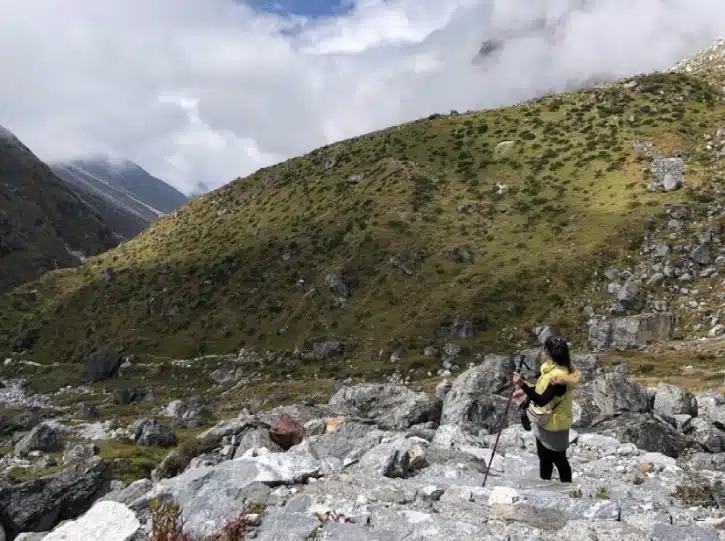
However, our adventure didn’t end there. Inspired by the beauty of Tsho Rolpa, we continued our trek to Dudh Kunda Lake, which was just a 5-6 hour hike away. This is where the real challenge began. The path was treacherous, with slippery and congested sandy trails that tested our endurance. Yet the reward was worth every step. We encountered a stunning array of multicolored flowers that seemed to dance in the gentle breeze, a reminder of nature’s artistry.
As we reached Dudh Kunda, the monsoon fog enveloped us, obscuring the view but adding an air of mystery to the experience. After a grueling 12-hour trek, we finally made our way back down to Tsho Rolpa, grateful for the guidance of our local guide, who ensured our safety throughout the journey.
Day 5: Return to Simigaun
We returned to Simigaun on our last day. One local humorously remarked, “ए भाइबहिनीहरू, तिमीहरू पदयात्रा हिडेको कि रेस खेलेको?” Did you go trekking or join a race? We laughed, realizing that our adventure had indeed felt like a race against time, but it was also a journey of discovery and camaraderie.
Day 06: Drive back to Kathmandu
After a few days of ascending and descending, we concluded the Tsho Rolpa Hike with a quick descent to Singati and then hopped on a bus. Before heading back to Kathmandu, we made a stop at the Dolakha Bhimsen Temple, a beautiful site to offer gratitude to God for that incredible journey.
We were back in Kathmandu by 4 PM, where we parted ways for our respective homes.
Hike to Tsho Rolpa: A Journey that Reshaped Me
My trek to Tsho Rolpa and Dudh Kunda was not just an adventure; it was a profound exploration of the interconnectedness of nature, wildlife, and local livelihoods in the Rolwaling Valley. As the sun rose over the majestic peaks, casting a golden hue on the glacial lakes, I felt a deep sense of gratitude for the beauty surrounding me. Watching the mighty Melungste (7181 m) and Gaurishankar (7134), the highest peaks in the Rolwaling range each time, was a quiet reminder of nature’s timeless power.
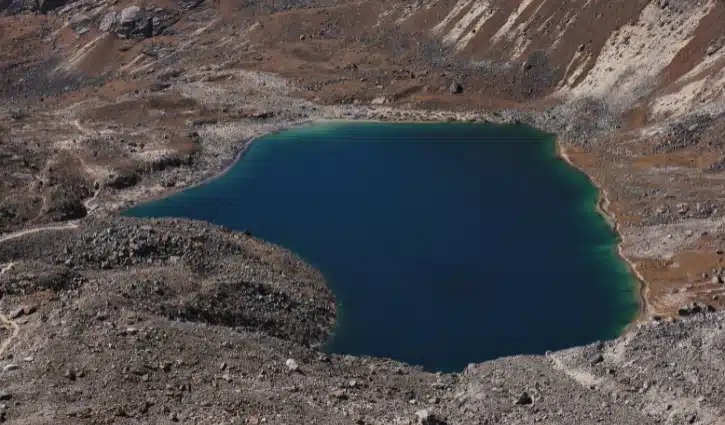
The shimmering turquoise waters of Tsho Rolpa are vital lifelines for the region, nourishing both the land and the communities that depend on them. Encountering wild cows grazing peacefully against this stunning backdrop reminded me of the rich biodiversity that thrives here, a testament to nature’s resilience. However, leopards attacking domesticated mountain goats are normal there, yet disadvantageous for humans.
The cascading waterfalls and lush valleys serve as a backdrop to the lives of the local Sherpa communities, who rely on sustainable practices to maintain their way of life. Their stories, filled with wisdom and a deep respect for the land, captured me. By promoting responsible tourism, we can support these livelihoods while ensuring the protection of this pristine environment.
What You Need to Know for Tsho Rolpa Hike:
Difficulty?
I would rate the Tsho Rolpa hike a moderate-level trek since the trail is mostly uphill and takes you to over 4000 meters. While it’s not as tough as other high-altitude treks like Everest Base Camp or the Annapurna Circuit, it still requires a good level of fitness.
The trail involves a mix of uphill and downhill sections through steep ridges, riversides, and forests. Since it is remotely located, there are fewer facilities and fewer people on the trail.
What to pack?
Since this is a short hike, you don’t need so many clothes, which is a burden to carry. However, pack warm clothes to sleep well in at night and comfortable pants and t-shirts for the day with a good, sturdy hiking boot. For mornings and evenings, pack layers of clothing. Down jackets and warm fleece are a must.
A few other essential items that come in handy are a power bank, hat, wet wipes, sunglasses, and sunscreen.
Moreover, a trekking pole would do wonders while hiking. So don’t forget to carry them.
Food
The sparse population of the Rolwaling Valley results in fewer teahouses. So, the food menu is basic, and the items are all locally produced. However, the foods are tasty and organic.
For breakfast, we have tea/coffee, Tibetan bread, eggs, pancakes, vegetable curry, and bread. For lunch and dinners, you get Momo, Dal Bhat (rice, lentil soup, and vegetable curries), noodles, spaghetti, pasta, and mushroom and garlic soup.
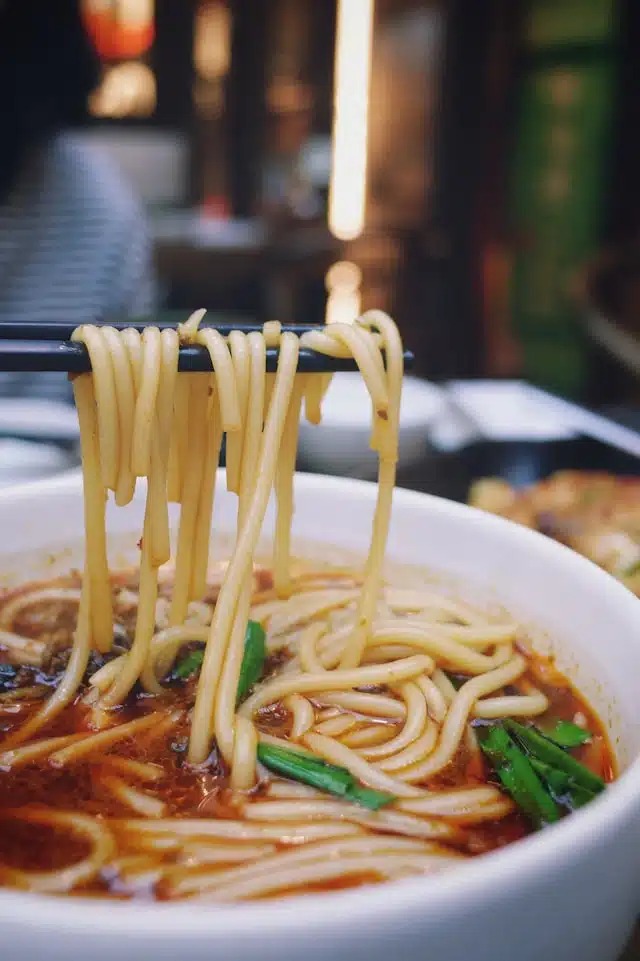
After crossing Kyalche, the villages have a strict policy of no animal killings. Thus, every food item along the trail will be vegetarian.
Transport
As for transport, buses are easily available from Kathmandu to Charikot, Dolakha (approximately 130 km), and then Singati (the trek starting point). Some buses take you directly to Singati, while few have stops at Charikot. You can also take a Jeep ride from Charikot to Singati, which is around 40 kilometers.
The best time to go
Although we hiked in the monsoon, I would point out the best time to be March to early May or late September to December for the best weather, clear sky, and overall trekking experience.
Every time of the year has a special benefit along with a challenge. So, be sure to understand all the challenges before choosing your time of year.
In the end,
As you embark on your hike to Rolwaling, take the time to appreciate the surrounding beauty. Don’t rush; savor each moment, breathe in the crisp mountain air, and let the sound of rushing water soothe your spirit. Together, let’s commit to safeguarding the treasures of the Rolwaling Valley, ensuring that its stunning landscapes and rich biodiversity continue to inspire generations to come.
So, lace up your hiking boots, embrace the spirit of exploration, and let the wonders of nature call you to adventure. The Rolwaling Valley awaits, and its magic is ready to unfold!


